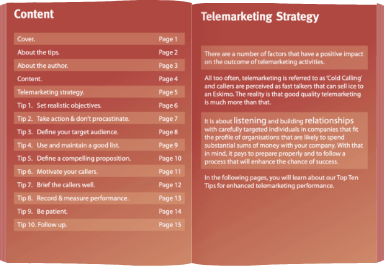Cold calling is dead they say. The telephone is outmoded as a marketing tool and social media in the place to be.
In some ways, there is some truth in each of those statements. Pure cold calling is possibly less effective than it used to be with increasing use of voicemail, opt-outs, and layers in organisations that mean it’s harder to reach decision makers to have a conversation. These days, a more intelligent blended approach to calling is often required. Equally, the younger generation is perhaps less reliant on the telephone as a means of communication. They were born with a mobile phone to their ears and an iPad in their hand. What’s more, everyone is on Facebook and, professionally, we’re all on LinkedIn.
So, does the telephone still have a role to play in b2b marketing? Our client experience suggests that it still plays a strong role and we’ve detailed 10 ways that you can use telemarketing to grow your business.
1. Telemarketing Lead Generation
This is kind of obvious but it is the solution that is most usually used where companies want to grow their business. Generally, it starts with the desire to sell products or services into a defined target market. The more precise the targeting, the more likely the campaign will be successful. The same goes for the marketing list. Typically, in this instance, the leads are cold and the prospects are not expecting a call. However, appointment setting exercises such as these can deliver extremely good ROI. Imagine calling the Marketing Director of Tesco with a proposition to which they respond favourably. And, imagine that this results in a sale and long-term relationship that possibly reaches a six figure revenue. How much telemarketing might be appropriate to set against such an opportunity? If it took six months and 10% of the revenue for year 1, would it be worthwhile?
2. Telemarketing to Follow-up Inbound Leads
Inbound enquiry management is critical to success. Not following up inbound leads swiftly means you may be squandering the money you spend on the activities that drove those leads to you.
It’s not unreasonable to say that most other methods of marketing are relatively passive. In other words, you have to wait for a response. Some are hopefully quite speedy (e.g. PPC / Adwords where they might make an enquiry or you track who visits based on a web tracking tool) but most involve you spending a sum of money and waiting (hoping) for a response. Social media can’t really compete here. You hope that, by virtue of the number of connections/followers, those individuals will share your content and your customers will find it and call you. The fact is that it can be a slow burn. That’s, to some extent, the same for other solutions. You have to wait for them to come to you.
With telemarketing it’s different. You go to them and you keep doing so until you have an outcome. And, it’s very measurable.
What is interesting, however, is how you might use telemarketing in conjunction with other channels. How well do you follow up event leads? And how quickly, before they go stale? And what about enquiries generated by online marketing? How fast are these followed up? Likewise, web tools abound that can allegedly identify the companies visiting your website. How do you target the right individuals without a call to find out who it is? And, what about LinkedIn? If you’ve requested or made a connection and messaged them and they don’t respond, what do you do? Do you just drop it or might you make a phone call to follow-up the connection recognising that they may be busy?
The point is that telemarketing can amplify the return on investment from other channels that could otherwise be wasted if a call isn’t used to generate an outcome.
3. Telemarketing to Lapsed Customers
We recently carried out an exercise for a client whereby we took a large list of customer from whom they hadn’t heard for 18+ months. They didn’t have the internal resources to keep in touch with these lower value customers. So, they asked GSA to make the calls. We achieved significant new orders and leads for the business and performed a customer care role that reduced the likelihood of those customers defecting to competitors. This is a regular story. Not least in most medium to large companies, there is a database of customers that feel unloved. Telemarketing can be used very effectively to not only generate sales opportunities and build the sales pipeline but also to unearth valuable market research information as to the status of those customers and reasons for inactivity.
4. Telemarketing for Cross-Sell
Time is at a premium for most business people. Internal sales and customer service staff are often tied up dealing with what’s in front of them. Necessity means that they have to deal with key and larger accounts and those that shout loudest get heard. However, there are generally a significant number of customers that would purchase more from your business if they knew you stocked those products or offered those services. That’s especially true if they’ve been buying the same things for a long time. A customer care type call can identify new opportunities for cross-selling within the current client base.
5. Telemarketing for New Product Launches
Similar to cross-sell, it may be that you have a new launch and need to alert your customers alongside prospects. Of course, like above, you can use email but how many customers or prospects will respond. For higher value sales, a face to face sales appointment is generally necessary and how many recipients of an email will simply pick up the phone to ask for a sales visit. Telemarketing takes away the inertia and is a proactive way to generate sales.
6. Telemarketing for Online Demos
Sometimes, prospects can be put off by hard-nosed sales calls that try to squeeze a face to face appointment for a sales person. A lower risk commitment for a prospect is a web demo. Telemarketing can be used effectively to run short web demos or to run prospects through a web page designed to generate a call to action.
7. Telemarketing for Research or Customer Care
It’s amazing the opportunities that these kinds of calls can elicit if managed correctly. A well-placed service or customer satisfaction research call can stimulate needs that would have otherwise not come out due to how busy customers can be. Calls such as these also promote a positive image of your company and brand that go well beyond the specific call. And, it’s well documented that satisfied customers can be tempted away by offers whereas delighted customers remain loyal.
8. Telemarketing for Data-Building & Cleaning
Most marketing campaigns fail due to poor targeting. And poor targeting often comes from inaccurate data to start with. If you’re planning a sales push, it makes sense to ensure that the data you’re using is accurate. One of the most effective ways to do this is to call the companies to establish that you have the correct individuals and that they actually look after your area of interest since their job title may be misleading. You can use the phone in conjunction with LinkedIn and other sources.
This is especially important if the value of the sale is high and you’re spending money for example on an expensive direct mail piece. Most data brokers will only say that their data is accurate to within 6 months. In reality, 12 months is more likely. In most sectors, jobs change regularly and it, therefore, makes good business sense to work on your data before you kick off.
9. Telemarketing for Soft Lead Generation
Soft lead generation is perhaps less well-known than its big brother cold-calling. This is a way of determining if a prospect meets your criteria and has an interest in talking further. This is accomplished by tightly scripting an approach and asking 4 or 5 relevant profiling questions before asking a final question such as “Would you like to hear further from our one of my colleagues regarding …….?” We have used this for many campaigns with great success since it is more of a soft-sell on the back of profiling rather than an overt sales approach.
10. Telemarketing for Mystery Shopping
Mystery shopping perhaps would not have been considered as telemarketing. However, an understanding or your competitors and how you’re performing is essential if you want to grow. You need to understand how your own staff are performing and it’s really useful to evaluate what your competitors offer so you can further differentiate what you supply to market. A well-structured calling campaign can yield a tremendous amount of information upon which you can act and make the necessary tweaks and changes to develop your business.
Whilst telemarketing perhaps has an unfair reputation and is labeled as cold-calling and nothing else, in reality, there are a number of uses that can have a big impact on the growth of your sales and business.
GSA helps businesses become more effective in their marketing and business development. We run outbound telemarketing campaigns into the UK, Europe and further afield. Also, with our experience, we provide telemarketing training to help sales teams improve their results. If you’d like to know more, give us a call.






